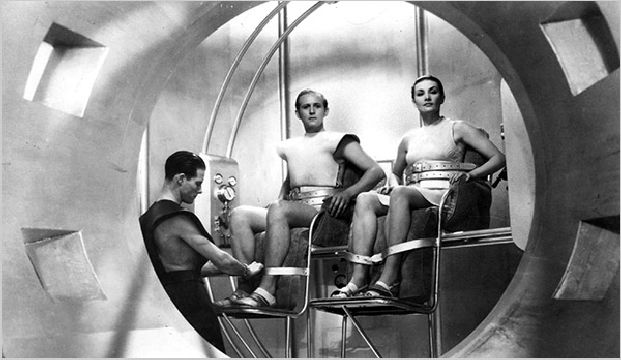Things to Come (1936) 
“The future is here!”

Director: William Cameron Menzies
Cast: Raymond Massey, Edward Chapman, Ralph Richardson
Synopsis: The story of a century: a decades-long second World War leaves plague and anarchy, then a rational state rebuilds civilization and attempts space travel.
Hungarian emigre Alexander Korda was undoubtedly the only filmmaker operating in Britain in the mid-1930s capable of producing a movie on the scale of Things to Come, and it’s impossible to criticise the ambition and vision of the man. Based on H. G. Wells’ 1933 novel The Shape of Things to Come, Korda hired the famed writer — who, to be honest, was way past his best by this time in his life — and pretty much gave him full creative control over the story. Not that such a unique honour counted for much in post-production. On its release in February 1936 the movie was, at 108 minutes, more than 20 minutes shorter than its original draft version. It was cut even further after release, and the version in existence today is just 96 minutes long. In terms of entertainment value, 96 minutes is still too long, but in terms of plot Things to Come sorely misses that extra 34 minutes.
The movie begins in the fictional town of Everytown (based on London) in 1940, on the eve of a global war that will devastate the world. Wells’ was just sixteen months out in his prediction about the outbreak of war, but he had it lasting 26 years instead of just six. The decimation of Everytown under a concerted bombing campaign by the unnamed enemy is impressively handled, and the following montage sequence highlights a war that lasts for a generation, although little attention is paid to the impact on the male population in that time. In reality, the adult male population of the participating countries would be virtually wiped out in such a war, but the movie glosses over this impact to concentrate, instead, on the sociological impact on a society that is cast back to the middle-ages in which the country is divided into small fiefdoms.
Everytown comes under the influence of The Boss (not Bruce Springsteen, but Ralph Richardson giving the movie’s most memorable performance), a despotic character who quickly takes advantage of the vacuum of power that arises following the downfall of established sociological and political protocol, and orchestrates the elimination of the poor souls affected by the walking sickness, a kind of infectious but benign zombie-like state. The Boss is a megalomaniac who wears a uniform reminiscent of those worn by the Nazis, and whose fixation on establishing an air force echoes that of Italian fascist dictator Benito Mussolini’s. When John Cabal (Raymond Massey), a character we first met on the eve of the war, appears in a futuristic airplane, The Boss orders his capture and imprisonment. However, Cabal is a representative of Wings Over the World, a new civilisation operating out of Basra in Iraq.
Needless to say, The Boss’s tin-pot dictatorship is no match for the technological sophistication of Cabal’s organisation, and he suffers a near-Shakespearian downfall as Wings Over the World cloak his entire empire in sleeping gas. There then follows another lengthy montage sequence showing the gigantic technological strides taken by mankind in the following half-century, at the end of which we observe a society under threat of discord on the eve of a proposed journey to the stars.
It’s impossible to criticise Things to Come for its impressively ambitious vision of a world in a constant state of flux. It was directed by the American William Cameron Menzies, possibly due, in part, to his experience with massive sets as an art director on such movies as Thief of Baghdad. The sets here were designed by Alexander Korda’s brother Vincent, but seeing the gigantic, futuristic sets of the Everytown of the future, it’s difficult to believe that Menzies didn’t have some kind of influence over their design. Unfortunately, the spectacular sets look somewhat incongruous today when serving as a backdrop to some terribly stagy acting by performers reading lines that come across as prepared speeches and lectures rather than spontaneous conversations. The middle section, in which civilisation is reduced to a collection of warring, rubble-strewn communities is by far the film’s strongest portion but, like the rest of the movie, it lacks any kind of emotional resonance because of Wells’ sterile dialogue and the episodic nature of its tale.
As always with these type of movies, it’s interesting to see how accurate its predictions for the future are. Wells’ prediction of a global war within a few years of the movie being made was a commonly held one in the mid-1930s, so perhaps isn’t as prescient as it might at first seem, but he was spot on with flat screen TVs, space travel and the paranoia that inevitably accompanies any technological breakthrough. He was definitely way out on the price of newspapers, though — even today, their price falls far short of the £4.00 he predicted for 1966…
(Reviewed 17th September 2013)
httpv://www.youtube.com/watch?v=eUlRuiZ_68Q
